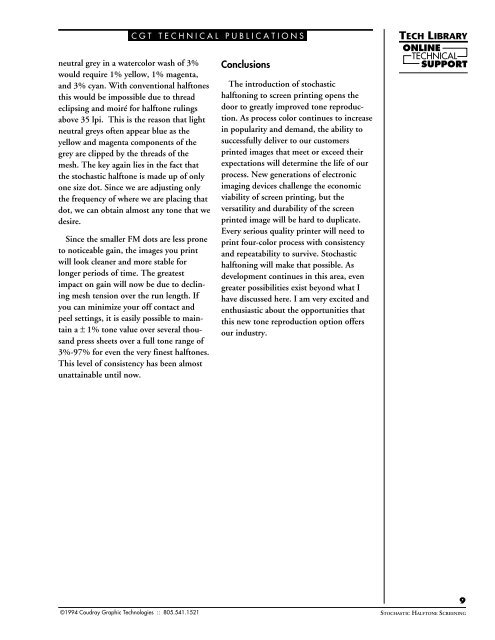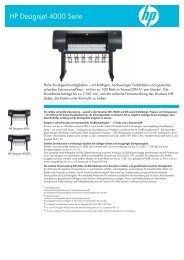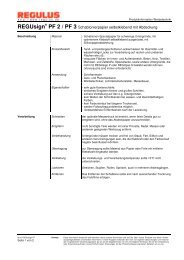STOCHASTIC HALFTONE SCREENING
STOCHASTIC HALFTONE SCREENING
STOCHASTIC HALFTONE SCREENING
You also want an ePaper? Increase the reach of your titles
YUMPU automatically turns print PDFs into web optimized ePapers that Google loves.
C G T T E C H N I C A L P U B L I C A T I O N S<br />
neutral grey in a watercolor wash of 3%<br />
would require 1% yellow, 1% magenta,<br />
and 3% cyan. With conventional halftones<br />
this would be impossible due to thread<br />
eclipsing and moiré for halftone rulings<br />
above 35 lpi. This is the reason that light<br />
neutral greys often appear blue as the<br />
yellow and magenta components of the<br />
grey are clipped by the threads of the<br />
mesh. The key again lies in the fact that<br />
the stochastic halftone is made up of only<br />
one size dot. Since we are adjusting only<br />
the frequency of where we are placing that<br />
dot, we can obtain almost any tone that we<br />
desire.<br />
Since the smaller FM dots are less prone<br />
to noticeable gain, the images you print<br />
will look cleaner and more stable for<br />
longer periods of time. The greatest<br />
impact on gain will now be due to declining<br />
mesh tension over the run length. If<br />
you can minimize your off contact and<br />
peel settings, it is easily possible to maintain<br />
a ± 1% tone value over several thousand<br />
press sheets over a full tone range of<br />
3%-97% for even the very finest halftones.<br />
This level of consistency has been almost<br />
unattainable until now.<br />
Conclusions<br />
The introduction of stochastic<br />
halftoning to screen printing opens the<br />
door to greatly improved tone reproduction.<br />
As process color continues to increase<br />
in popularity and demand, the ability to<br />
successfully deliver to our customers<br />
printed images that meet or exceed their<br />
expectations will determine the life of our<br />
process. New generations of electronic<br />
imaging devices challenge the economic<br />
viability of screen printing, but the<br />
versatility and durability of the screen<br />
printed image will be hard to duplicate.<br />
Every serious quality printer will need to<br />
print four-color process with consistency<br />
and repeatability to survive. Stochastic<br />
halftoning will make that possible. As<br />
development continues in this area, even<br />
greater possibilities exist beyond what I<br />
have discussed here. I am very excited and<br />
enthusiastic about the opportunities that<br />
this new tone reproduction option offers<br />
our industry.<br />
TECH LIBRARY<br />
ONLINE<br />
TECHNICAL<br />
SUPPORT<br />
©1994 Coudray Graphic Technologies :: 805.541.1521 <strong>STOCHASTIC</strong> <strong>HALFTONE</strong> <strong>SCREENING</strong><br />
9
















